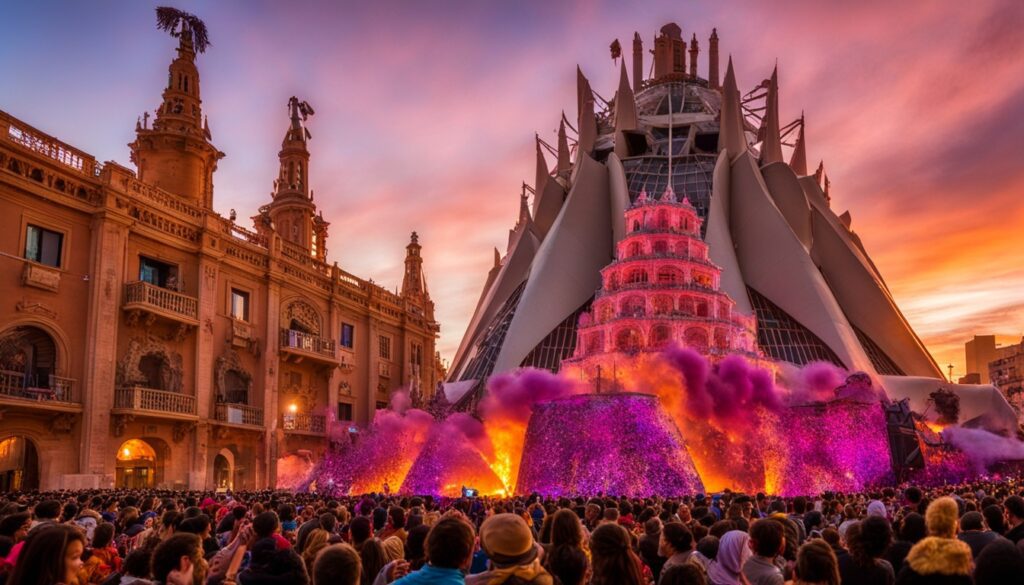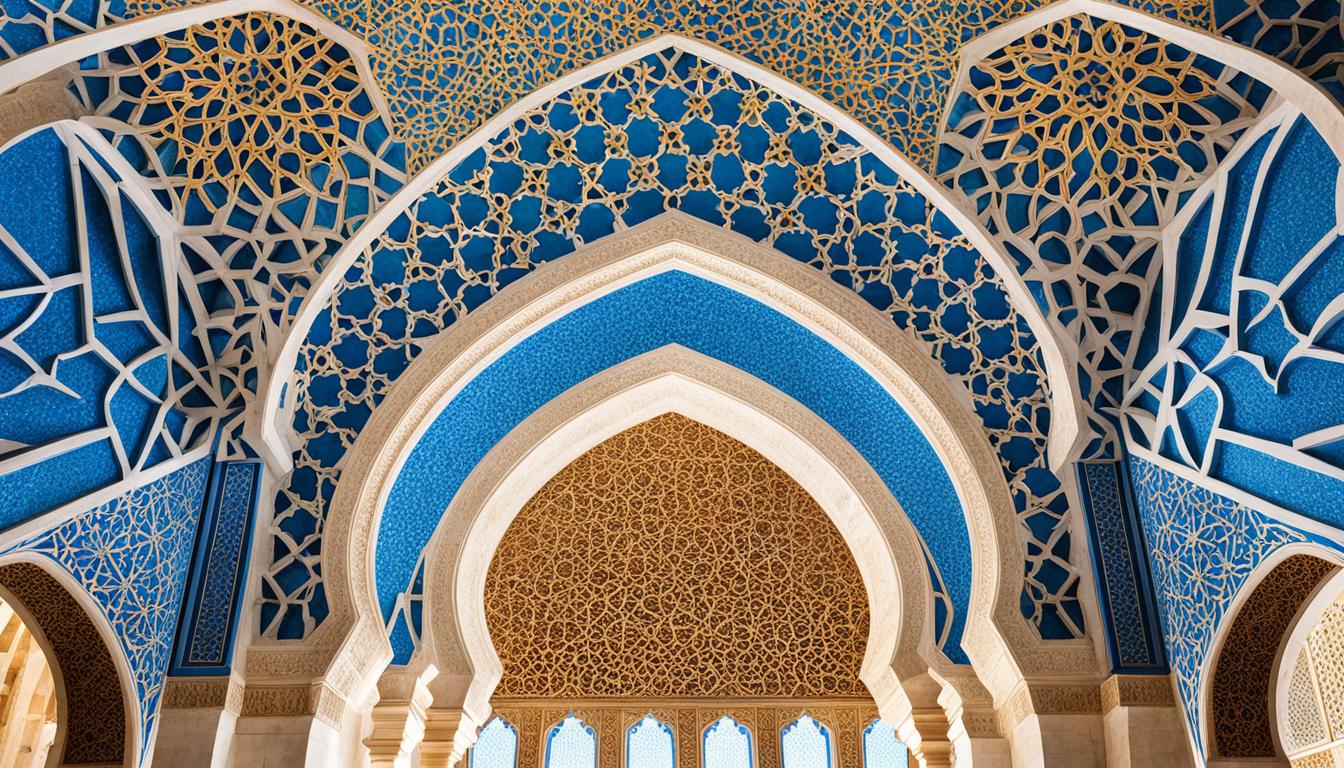Valencia is a city on Spain’s eastern coast with a rich history. It goes back to Roman times and the Moorish rule. The city is known for its beautiful Moorish architecture and the famous Silk Exchange, La Lonja de la Seda. These show its lasting cultural impact.
The story of the Holy Grail is at the heart of Valencia’s history. It says the Grail is in the city’s big cathedral. This old story has made the city even more fascinating to visitors and locals.
Valencia is also famous for its lively festivals, like the Fallas celebration. This festival honors the city’s cultural traditions. The city offers more than just history, with its delicious paella and beautiful Turia River Gardens.
Key Takeaways
- Valencia boasts a rich history dating back to its Roman and Moorish roots
- The city’s Moorish architecture, including the legendary La Lonja de la Seda, showcases its cultural heritage
- The legend of the Holy Grail has long captivated visitors to Valencia’s magnificent cathedral
- The city is renowned for its vibrant festivals, such as the iconic Fallas celebration
- Valencia’s natural and culinary delights, from the Turia River Gardens to the iconic paella, add to its enduring appeal
Valencia: A Mediterranean Gem Steeped in Culture
Valencia, Spain’s third-largest city, is a captivating place. It mixes its rich Moorish past with a lively modern culture. The city’s beautiful Moorish architecture shows its history as a key spot in the silk trade. The La Lonja de la Seda, or the Silk Exchange, is a UNESCO site. It’s a beautiful reminder of Valencia’s wealthy past.
Moorish Architecture and the Silk Trade
During Moorish rule from 714 AD to 1238 AD, Valencia thrived in trade and culture. The Moors left a lasting impact on the city’s buildings. This is seen in the La Lonja de la Seda, a Gothic-style building from the 15th century. It was the heart of Valencia’s silk trade.
La Lonja de la Seda: A Legendary Silk Exchange
The La Lonja de la Seda was built from 1482 to 1548. It’s a stunning building with high ceilings and columns like palm trees. Visitors can see how the city was a key player in the silk trade during the Renaissance. The Silk Exchange shows Valencia’s lasting cultural heritage and its important role in global trade.
“The Silk Exchange era in Valencia during the 15th century marked a period of prosperity due to the booming silk industry.”
Legendary Origins: The Quest for the Holy Grail
Valencia’s history is closely linked to the Holy Grail legend. This sacred chalice was said to be used by Jesus at the Last Supper. It was brought to Spain and found its way to Valencia Cathedral in the 15th century.
Those interested in Valencia’s religious past can follow the “Grail Route.” This path takes you to the Church of San Nicolás, known for its beautiful frescoes. It also leads to the cathedral, where the Chapel of the Holy Chalice is located.
The story of the Holy Grail is full of mystery. Over time, it has been seen as a cup, dish, or stone with magical powers. These powers include giving eternal youth, healing lands, and offering eternal life.
The word “grail” comes from Old French, Old Occitan, and Latin. Some believe it relates to woven baskets, Greek wine vessels, or Latin terms for dishes and royal blood.
In Arthurian stories, the Grail is a key element. It tells of King Arthur’s knights going on quests for the Grail. These stories also delve into the Grail’s past, especially in Joseph of Arimathea’s time.
Many famous writers have added their own twists to the Grail legend. Authors like Chrétien de Troyes, Wolfram von Eschenbach, Robert de Boron, and those of the Lancelot-Grail Cycle have each brought their own stories to the table.
Europe alone has over 200 places claiming to have the Holy Grail. Some think it might be in Scotland or Accokeek, Maryland.
Valencia’s Santo Cáliz is a top contender for the Holy Grail. This agate cup, from the Middle East around 2nd Century BC to 1st Century AD, is believed to be the real deal. It was in King Martin of Aragon’s collection by 1399 and then given to Valencia Cathedral. Popes John Paul II and Benedict XVI have both used it in ceremonies.
“The Holy Grail is a treasure depicted in Arthurian literature with miraculous healing powers, often described as a cup, dish, or stone with abilities like providing eternal youth, restoring wastelands, and granting ascension or eternal life.”
A Culinary Odyssey: Valencian Wines and Tapas
Valencia is more than just a place with history and culture; it’s a food lover’s dream. The area is famous for its top-notch wines, especially the whites and reds from Requena-Utiel. These wines are perfect with the city’s well-known tapas. Visitors can explore the vineyards and taste these wines that go great with tapas.
Exploring the Vineyards of Requena-Utiel
Requena-Utiel is close to Valencia and is a key wine region. It has over 40,000 hectares of vineyards. Here, you can find a wide variety of valencian wines loved around the world. You can visit the beautiful vineyards, learn how wine is made, and taste the famous red and white wines.
The Agua de Valencia: A Local Cocktail Tradition
Valencia is also famous for its special drink, the Agua de Valencia. It’s a fizzy, sweet drink made with cava, orange juice, and vodka or gin. Enjoying an Agua de Valencia with paella is a key part of the Valencian experience.
“Valencia’s culinary scene is a harmonious blend of tradition and innovation, showcasing the region’s rich agricultural heritage and the creativity of its chefs and bartenders.” – Michelin Guide
Visiting Valencia’s food and drink scene is a must for travelers. It shows off the city’s deep food traditions and its growth as a food destination.
Las Fallas: Unraveling the History of Valencia’s Iconic Festival
No visit to Valencia is complete without experiencing Las Fallas. This festival, ending on March 19th, shows off Valencia’s deep culture. You can learn about its history and traditions at the Fallero Museum. Here, you’ll find ninots (giant papier-mâché figures) that were saved from the flames.
The festival started with burning wooden logs on Saint Joseph’s Day eve, a spring celebration. It grew into making ninots, huge sculptures made by local artists. These are shown around the city before being burned on the last day.
At the Fallas Museum and Fallero Museum, you can see the art of Las Fallas up close. These museums highlight the hard work of artists making these amazing sculptures. They give a peek into Valencia’s unique culture.
“Las Fallas is a testament to Valencia’s unwavering spirit, where tradition and innovation converge in a captivating display of fire, art, and community.”

Las Fallas is unforgettable, with its bright colors, lively music, and strong community feeling. It’s a celebration of Valencia’s culture, from the historic Fallero Museum to today’s modern ninots. It’s a must-see for anyone wanting to explore this amazing Spanish city.
Exploring Valencia’s Agricultural Roots
Valencia’s farming history is a big part of its identity. Its lively market gardens and green orchards are key to the local economy and food scene. Visitors can dive into this farming lifestyle and learn about the traditions that have lasted for many years.
A Day in the Market Gardens and Orchards
One great way to see Valencia’s farming roots is by taking a horse-drawn carriage tour of the market gardens and orchards around the city. You’ll ride through green fields and pick your own fruits and veggies. This lets you see the effort and love that farmers put into their work.
The Horchata Route: A Sweet Valencian Tradition
Don’t miss the Horchata Route, a path that shows you the city’s orchards and teaches you about the tiger nut drink, horchata. You’ll hear about its history and why it’s so important to the Valencian people. This drink has been a favorite for centuries.
“The market gardens and orchards of Valencia are not just the foundation of our cuisine, but the very essence of our culture. They are the heartbeat of our city, connecting us to the land and the rhythms of the seasons.”
– José Andrés, renowned Valencian chef and restaurateur
La Albufera: A Natural Oasis on Valencia’s Doorstep
Close to Valencia’s busy city center is the beautiful La Albufera. It’s a huge lake with green wetlands and rice fields. This place is a peaceful escape from the city, showing off the area’s farming history.
Boat Rides and Paella in El Palmar
Visiting La Albufera means you can go on a boat ride on its calm lake. Then, head to the village of El Palmar, famous for its great paella. This dish uses eels and ingredients from the lake. Enjoy this famous Spanish meal in a beautiful setting.

“Exploring La Albufera and trying the real paella of El Palmar is a must for Valencia visitors. It’s a way to experience the area’s beauty and food culture.”
La Albufera and El Palmar are perfect for those looking for peace or wanting to learn about Valencia’s farming. They offer stunning nature and delicious food that make Spain special.
valencia spain history: Uncovering Hidden Gems
Valencia is more than just famous landmarks. It’s full of hidden spots that show off its deep history and culture. El Cabanyal, a former fishing village, is one such place. It’s now a spot where artists and visitors love to go.
El Cabanyal: A Neighborhood Reborn
El Cabanyal was once the muse of Spanish painter Joaquín Sorolla. Now, it’s a place full of creativity and realness. The old 19th-century buildings are still there, but now they house cool cultural spots and new eateries. You can feel the sea in the air as you wander the streets, taking in the vibe of this reborn area.
Valencia has more than just the famous sights. It has hidden museums, markets, and festivals that give you a real feel of the place. If you visit during quiet times or special seasons, you can enjoy these spots without the crowds. The city’s good public transport makes it easy to get around to these hidden spots.
Staying in a boutique hotel, eating at a local spot, or going to a festival lets you really dive into Valencia’s culture. With a good plan, you can see the real heart of this Spanish city. You’ll find out what makes it special, beyond the usual tourist areas.
Valencia’s Surrounding Treasures: Agricultural Excursions
Beyond Valencia’s lively streets, the areas around offer a journey into the region’s farming past. Travelers can go on agricultural excursions to see the special crops and traditions that make Valencia’s food unique.
Sueca is famous for its big rice fields that support the paella tradition. Inland, Relleu is known for its almond farms. Planes and Alcoy are famous for their sweet cherries.
Going north, you can visit Alboraya to see where horchata, a creamy drink, is made from tiger nuts. Ayora and Cofrentes are known for their great honey. Onteniente is famous for its persimmons, a tasty autumn fruit.
If you love citrus, visiting Villareal, the “citrus capital of Europe,” is a must. You can see the citrus groves and learn about the citrus industry. Viver and Vilafamés are known for their amazing olive oil from old olive trees.
These trips let travelers dive into the food traditions of the Valencian countryside. They offer a deeper understanding of the area’s rich culture.
“Experiencing the agricultural heart of Valencia is a truly remarkable way to connect with the essence of this remarkable region.” – Jane Doe, travel writer
Conclusion
Valencia is a captivating place for travelers with its rich history and cultural heritage. It has Moorish architecture and stories of the Holy Grail. The city also has vibrant festivals and roots in agriculture.
Visitors can explore hidden gems, try famous wines and tapas, or enjoy nature. Everyone leaves with a deep love for this Spanish city. Valencia’s history spans centuries, offering a mix of old and new experiences.
The city’s Moorish buildings and lively festivals are truly captivating. Walking through its streets, you’ll find a blend of tradition and modern life. This shows the strength and creativity of its people, who have kept Valencia’s spirit alive through history.

